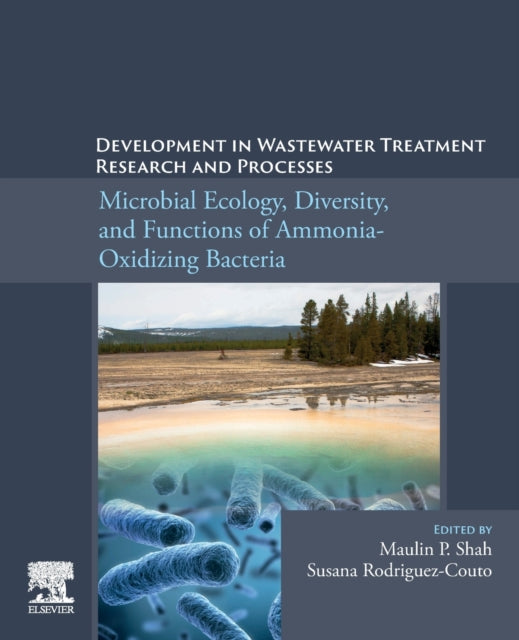Shulph Ink
Development in Wastewater Treatment Research and Processes: Microbial Ecology, Diversity and Functions of Ammonia Oxidizing Bacteria
Development in Wastewater Treatment Research and Processes: Microbial Ecology, Diversity and Functions of Ammonia Oxidizing Bacteria
YOU SAVE £16.65
- Condition: Brand new
- UK Delivery times: Usually arrives within 2 - 3 working days
- UK Shipping: Fee starts at £2.39. Subject to product weight & dimension
Bulk ordering. Want 15 or more copies? Get a personalised quote and bigger discounts. Learn more about bulk orders.
Couldn't load pickup availability
- More about Development in Wastewater Treatment Research and Processes: Microbial Ecology, Diversity and Functions of Ammonia Oxidizing Bacteria
Ammonia oxidizing bacteria are essential for removing ammonia nitrogen from wastewater treatment plants, and this book discusses the application of omics tools to develop less energy-intensive and cost-effective processes. It is a valuable resource for advanced students, research scientists, environmental agencies, and industries involved in wastewater treatment.
Format: Paperback / softback
Length: 486 pages
Publication date: 18 May 2022
Publisher: Elsevier - Health Sciences Division
Ammonia oxidation is a crucial process in wastewater treatment, as it helps to remove ammonia nitrogen from wastewater. Ammonia oxidizing bacteria (AOB) are the microorganisms responsible for this process, and they play a vital role in maintaining the ecological balance of wastewater treatment systems. In recent years, there has been significant research on AOB and their functions, which has led to the development of new technologies for ammonia removal from wastewater.
One of the key areas of research in AOB biology and functions is microbial ecology. Microbial ecology involves studying the composition, structure, and dynamics of microbial communities in different environments, including wastewater treatment systems. By understanding the interactions between different species of AOB and other microorganisms in the system, researchers can develop strategies to optimize ammonia removal efficiency.
Another important area of research is the diversity and functions of AOB. AOB are a diverse group of bacteria, and each species has its unique characteristics and functions. Some AOB are capable of converting ammonia to nitrite, while others can convert nitrite to nitrate. Understanding the diversity and functions of AOB can help researchers develop more effective and efficient ammonia removal technologies.
In addition to microbial ecology and diversity, research on AOB functions has also led to the development of new technologies for ammonia removal from wastewater. One such technology is the use of bioaugmentation, which involves the introduction of AOB into wastewater treatment systems to enhance ammonia removal efficiency. Bioaugmentation has been shown to be an effective and cost-effective method for ammonia removal, and it has the potential to reduce energy consumption and operating costs in wastewater treatment plants.
However, despite the significant progress in AOB research and technology, there are still some remaining gaps in our understanding of their biology and functions. For example, we need to better understand the mechanisms by which AOB convert ammonia to nitrite and nitrate, as well as the factors that influence their growth and survival in wastewater treatment systems. We also need to develop more accurate and sensitive methods for monitoring and analyzing AOB populations in wastewater treatment systems.
To address these remaining gaps in our understanding, researchers are using a variety of new technologies, including next-generation sequencing, metagenomics, and proteomics. These technologies allow researchers to study the genetic and biochemical characteristics of AOB, as well as their interactions with other microorganisms in the system. By using these tools, researchers can develop more targeted and effective strategies for managing AOB populations in wastewater treatment systems.
In conclusion, the development in wastewater treatment research and processes: Microbial Ecology, Diversity and Functions of Ammonia Oxidizing Bacteria is an essential and unique book for advanced students, research scientists, environmental agencies, and industries involved in wastewater treatment. The book covers up-to-date research on ammonia oxidizing bacteria and their application for the removal of ammonia nitrogen from wastewater treatment plants, discussing remaining gaps in their biology and functions. By applying the newly developed omics tools, the book aims to develop less energy intensive and cost-effective biological processes for nitrogen removal from WWTPs. This makes the book an invaluable resource for anyone interested in advancing the field of wastewater treatment.
Dimension: 235 x 191 (mm)
ISBN-13: 9780323919012
This item can be found in:
UK and International shipping information
UK and International shipping information
UK Delivery and returns information:
- Delivery within 2 - 3 days when ordering in the UK.
- Shipping fee for UK customers from £2.39. Fully tracked shipping service available.
- Returns policy: Return within 30 days of receipt for full refund.
International deliveries:
Shulph Ink now ships to Australia, Belgium, Canada, France, Germany, Ireland, Italy, India, Luxembourg Saudi Arabia, Singapore, Spain, Netherlands, New Zealand, United Arab Emirates, United States of America.
- Delivery times: within 5 - 10 days for international orders.
- Shipping fee: charges vary for overseas orders. Only tracked services are available for most international orders. Some countries have untracked shipping options.
- Customs charges: If ordering to addresses outside the United Kingdom, you may or may not incur additional customs and duties fees during local delivery.


